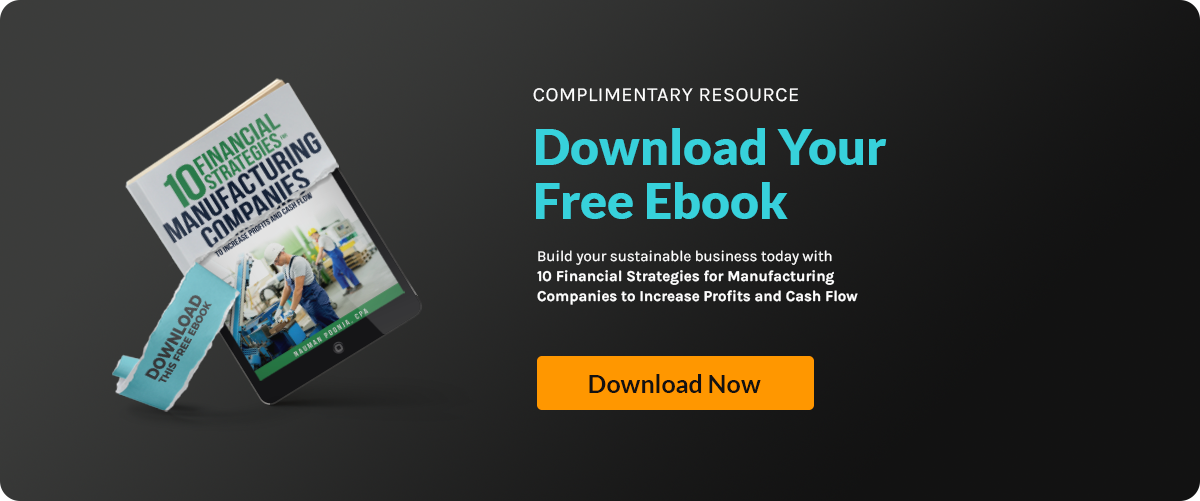The Chief Financial Officer (CFO) is not just the top accountant in the business. In a...
The Role of Capital Planning for Maximizing Profitability in Manufacturing

Do you need help determining where to invest your resources for the best returns? Many businesses face this challenge, but effective capital planning can significantly relieve this burden by clearly determining resource allocation.
Did you know that companies with solid capital planning frameworks experience a 30% reduction in project-related risks? This statistic underscores the impact of strategic investment. Reducing risks can significantly improve efficiency and cost management in the manufacturing industry, where project timelines and budgets are crucial.
Capital planning is about making informed decisions that align with your business goals. This proactive approach ensures that your investments yield the highest possible returns and keeps your company competitive.
Discover how capital planning can transform your financial strategy and increase profitability.
Maximizing Profitability with Effective Budgeting
Effective budgeting is essential for a manufacturing company to allocate capital wisely and manage cash flow efficiently. Companies can maximize profits and support sustainable growth by prioritizing investments based on market conditions and potential risks. Tools like net present value help organizations evaluate the present value of future cash flows, aligning financial resources with long-term financial goals. This approach reduces costs and ensures the company can adapt to changing market dynamics.
Budget Forecasting Process
Budget forecasting is closely connected to capital planning. It helps manufacturing businesses allocate resources effectively and prepare for future financial needs. A well-structured budget forecasting process ensures that capital budgeting decisions are aligned with the company’s financial goals. Here are the key phases of the budget forecasting process:
Phase 1: Establish Clear Objectives
Identify potential investments and set financial goals. This involves analyzing capital requirements and aligning them with long-term objectives.
Phase 2: Analyze Cash Inflows and Outflows
Assess expected cash inflows and outflows to determine the company's financial position. This step is vital for effective capital planning and working capital management.
Phase 3: Conduct Risk Assessment
Evaluate potential risks associated with investments. This helps in making informed decisions during the capital budgeting process.
Phase 4: Calculate Key Financial Metrics
Determine internal rate of return (IRR), net present value (NPV), payback period, and rate of return. These financial metrics provide insights into the profitability and feasibility of investments.
Phase 5: Diversify and Allocate Resources
Diversify investments to spread risk. Allocate resources based on the analysis to support high-priority projects.
Phase 6: Regularly Review and Adjust Forecasts
Review the budget forecasts regularly to ensure they reflect current market conditions and financial status. Make necessary adjustments to keep the estimates accurate and relevant. This regular review and adjustment process can provide a sense of reassurance and control over your financial strategy.
Integrating Budgeting into Capital Planning
Integrating budgeting into capital planning is crucial for maximizing profitability in manufacturing. Let's explore a scenario where a manufacturing business effectively integrates budgeting into its capital planning process.
The Initial Assessment
A manufacturing company is considering purchasing new machinery to increase production capacity. This involves evaluating the initial investment required, including the cost of the machinery, installation, and training. Conducting a thorough investment appraisal to understand the financial implications is essential.
Cost of Capital and Investment Appraisal
The company evaluates the cost of capital, which is the return rate needed to make the investment worthwhile. They use investment appraisal methods such as net present value (NPV) and internal rate of return (IRR) to assess the return of potential investments. This helps them understand the profitability and risks associated with each investment opportunity.
Budgeting Integration
The company integrates budgeting into its capital planning by aligning the machinery investment with its financial goals. It allocates capital to meet the initial investment needs while ensuring it has enough resources for other operational expenses. One essential step is creating a detailed budget forecast that includes projected cash flows and expected returns.
Ongoing Management
The company’s work does not end after purchasing the machinery. They continue to monitor its performance, regularly reviewing the budget to ensure that the actual return on investment aligns with their projections. This ongoing management is vital to the process, helping organizations optimize their capital planning and drive profitability.
Maximizing Profitability
By effectively integrating budgeting into capital planning, the company maximizes profitability. It ensures that all investments align strategically with its financial goals, leading to sustainable growth. Businesses can optimize their capital planning process by continuously evaluating and adjusting their budgets based on real-time data.
Key Financial Metrics for Manufacturing Businesses
Financial metrics play a crucial role in capital planning for manufacturing businesses. These metrics help evaluate and select investments that will optimize financial resources. Companies can ensure sufficient funds to support growth and profitability by understanding these key metrics. Here are the essential financial metrics for manufacturing businesses:
Key Metric #1 - Net Present Value (NPV)
NPV involves evaluating the present value of cash inflows from an investment minus the initial investment cost. It helps businesses make more informed decisions by showing the potential profitability of an investment.
Key Metric #2 - Internal Rate of Return (IRR)
IRR is the rate at which the net present value of all cash flows (inflows and outflows) from a project equals zero. It is used to assess the profitability of potential investments and compare the desirability of different projects.
Key Meric #3 - Profitability Index (PI)
PI is calculated by dividing the present value of future cash inflows by the initial investment. A PI more significant than 1 indicates a good investment opportunity, helping businesses prioritize projects that will contribute to growth and profitability.
Key Metric #4 - Payback Period
The payback period measures the time it takes for an investment to generate enough cash flows to recover its initial cost. This metric is essential for assessing investment risk and liquidity.
Key Metric #5 - Return on Investment (ROI)
ROI measures the gain or loss generated by an investment relative to its cost. It is a straightforward metric that helps businesses evaluate an investment's efficiency and potential to drive growth.
Key Metric #6 - Cash Flow Analysis
Cash flow analysis ensures businesses have sufficient liquidity to meet operational needs and invest in growth opportunities. Regular monitoring of cash inflows and outflows is vital for maintaining financial stability.
Key Metric #7 - Operating Margin
Operating margin is the ratio of operating income to net sales. It shows a company's efficiency in controlling costs and generating profit from operations, which is crucial for long-term sustainability.
Streamlining the Manufacturing Budget Process
Streamlining the manufacturing budget process is essential for improving efficiency and profitability. It helps businesses allocate resources more effectively and make informed decisions. Here are three situations where streamlining and how to achieve it are crucial.
Situation: Inefficient Supplier Terms
An inefficient supplier agreement can disrupt the manufacturing budget process. When terms with suppliers are not optimized, this can lead to higher costs and cash flow issues, which affect the manufacturing company's overall financial health.
What to Do:
Manufacturing businesses should negotiate better terms with suppliers to reduce costs. This involves evaluating and selecting suppliers who offer the best value. Regularly reviewing and adjusting supplier contracts can lead to more favorable terms and improved cash flow management.
Situation: Allocating Resources for New Projects
Allocating resources for new projects is a common challenge. If handled correctly, it can ensure a smooth manufacturing budget process. Allocating resources without affecting existing operations requires careful planning.
What to Do:
Conduct a thorough risk assessment to understand the potential impact on current operations. Use detailed project planning to allocate resources efficiently. Adjust your strategies based on real-time data to ensure smooth integration of new projects without disrupting ongoing processes.
Situation: Managing Cash Flow Fluctuations
Fluctuations in cash flow can severely impact the manufacturing budget process. Unexpected expenses or delayed payments can lead to financial instability, and a manufacturing company may need help maintaining a consistent cash flow.
What to Do:
Implement cash flow management practices that help organizations maintain stability. This includes regular monitoring of cash inflows and outflows and using forecasting tools to predict future cash flow needs. Streamlining this process helps adjust strategies promptly to mitigate risks and ensure financial stability.
Achieve Higher Profitability with Expert Capital Planning
Effective capital planning can uncover hidden growth opportunities and address inefficiencies, driving long-term success. At Accounovation, we simplify financial reports and leverage your unique financial patterns to optimize your capital planning. Our approach uncovers financial obstacles and maximizes profitability, ensuring your business grows sustainably.
Contact Accounovation now for a consultation and start maximizing your financial potential.







